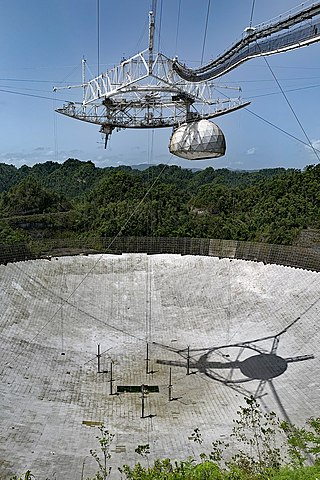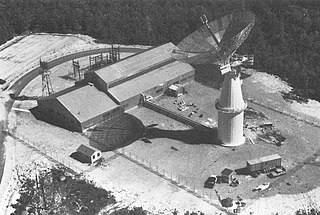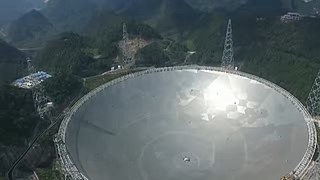
The following outline is provided as an overview and topical guide to space science:

A radio telescope is a specialized antenna and radio receiver used to detect radio waves from astronomical radio sources in the sky. Radio telescopes are the main observing instrument used in radio astronomy, which studies the radio frequency portion of the electromagnetic spectrum emitted by astronomical objects, just as optical telescopes are the main observing instrument used in traditional optical astronomy which studies the light wave portion of the spectrum coming from astronomical objects. Unlike optical telescopes, radio telescopes can be used in the daytime as well as at night.

Frank Donald Drake was an American astrophysicist and astrobiologist.

The Arecibo Observatory, also known as the National Astronomy and Ionosphere Center (NAIC) and formerly known as the Arecibo Ionosphere Observatory, is an observatory in Barrio Esperanza, Arecibo, Puerto Rico owned by the US National Science Foundation (NSF).

Radar astronomy is a technique of observing nearby astronomical objects by reflecting radio waves or microwaves off target objects and analyzing their reflections. Radar astronomy differs from radio astronomy in that the latter is a passive observation and the former an active one. Radar systems have been conducted for six decades applied to a wide range of Solar System studies. The radar transmission may either be pulsed or continuous. The strength of the radar return signal is proportional to the inverse fourth-power of the distance. Upgraded facilities, increased transceiver power, and improved apparatus have increased observational opportunities.

Aleksander Wolszczan is a Polish astronomer. He is the co-discoverer of the first confirmed extrasolar planets and pulsar planets.

William Edwin Gordon was an electrical engineer, physicist and astronomer. He was referred to as the "father of the Arecibo Observatory".

Sixto A. González Edick was the Director of the Arecibo Observatory from September 29, 2003, to September 15, 2006. Arecibo Observatory was an astronomical observatory located in Puerto Rico. At the time of González's directorship Arecibo was the world's largest single dish radio telescope. González was the first Puerto Rican in the position of Director of the observatory.
Gordon Hemenway Pettengill was an American radio astronomer and planetary physicist. He was one of the first to take radar from its original military application to its use as a tool for astronomy. He was professor emeritus at the Massachusetts Institute of Technology.

The Institute of Astronomy of Nicolaus Copernicus University in Toruń, known prior to 1 October 2019 in scientific publications as the Toruń Centre for Astronomy, is an optical and radio observatory located at in Piwnice, about 15 km north of Toruń, Poland. It houses two single-dish antenna telescopes, 32 metres and 15 metres in diameter, as well as the largest Polish optical telescope – 90 cm Schmidt-Cassegrain camera. The facility is operated by the Nicolaus Copernicus University. Also, photometry using 60 cm Cassegrain telescope is made and radio measurements of the Sun at 127 MHz frequency have been recorded on a daily basis since 1958 using a 23 m interferometer.

The Five-hundred-meter Aperture Spherical radio Telescope, nicknamed Tianyan, is a radio telescope located in the Dawodang depression (大窝凼洼地), a natural basin in Pingtang County, Guizhou, southwest China. FAST has a 500 m (1,600 ft) diameter dish constructed in a natural depression in the landscape. It is the world's largest filled-aperture radio telescope and the second-largest single-dish aperture, after the sparsely-filled RATAN-600 in Russia.

The Universities Space Research Association (USRA) was incorporated on March 12, 1969, in Washington, D.C. as a private, nonprofit corporation under the auspices of the National Academy of Sciences (NAS). Institutional membership in the association currently stands at 113 universities. All member institutions have graduate programs in space sciences or technology. Besides the 98 member institutions in the United States, there are two member institutions in Canada, four in Europe, two in Israel, one in Australia and one in New Zealand, one in Hong Kong, two in Korea and two in the United Kingdom.

The Arecibo Telescope was a 305 m (1,000 ft) spherical reflector radio telescope built into a natural sinkhole at the Arecibo Observatory located near Arecibo, Puerto Rico. A cable-mount steerable receiver and several radar transmitters for emitting signals were mounted 150 m (492 ft) above the dish. Completed in November 1963, the Arecibo Telescope was the world's largest single-aperture telescope for 53 years, until it was surpassed in July 2016 by the Five-hundred-meter Aperture Spherical Telescope (FAST) in Guizhou, China.

Tor Hagfors was a Norwegian scientist, radio astronomer, radar expert and a pioneer in the studies of the interactions between electromagnetic waves and plasma. In the early 1960s he was one of a handful of pioneering theorists that independently developed a theory that explained the scattering of radio waves by the free electrons in a plasma and applied the result to the ionosphere. He became founding director of the new EISCAT facilities that were then under construction in 1975, by which time he already been director at most of the other incoherent scatter radar facilities in the world. The asteroid 1985 VD1 is named 7279 Hagfors after him.
Philip D. Nicholson is an Australian-born professor of astronomy at Cornell University in the Astronomy department specialising in Planetary Sciences. He was editor-in-chief of the journal Icarus between 1998 and 2018.

The Argentine Institute of Radio Astronomy (IAR) was created in 1962 through an agreement between the scientific agencies CONICET and CIC, and the universities of La Plata and Buenos Aires. Its functions are to promote and coordinate the research and technical development of radio astronomy in Argentina and to collaborate in the teaching and dissemination of astrophysics and related disciplines. The Institute continues its activities in the dependency of the National Council of Scientific and Technical Research (CONICET), the Commission of Scientific Research of the Province of Buenos Aires (CICPBA) and the National University of La Plata (UNLP). Its current director is Dr. Gustavo E. Romero and its deputy director, Dr. Jorge A. Combi.

2017 YE5 is a binary pair of asteroids of approximately equal size and mass, each about 0.9 km (0.56 mi) in diameter. Classified as a near-Earth asteroid and potentially hazardous object of the Apollo group, 2017 YE5 was discovered by amateur astronomer Claudine Rinner at the Oukaïmeden Observatory on 21 December 2017. On 21 June 2018, the pair of asteroids passed within 15.5 lunar distances or approximately 6 million km (3.7 million mi) from Earth. During the close encounter, 2017 YE5 was resolved in high detail by concurrent radar observations by the Arecibo and Green Bank observatories, along with individual observations by the Goldstone Solar System Radar. 2017 YE5 is likely an extinct or dormant comet due to its distant elliptical orbit and dark red surface.

2020 BX12 is a sub-kilometer binary asteroid, classified as a near-Earth asteroid and potentially hazardous object of the Apollo group. It was discovered on 27 January 2020 by the Asteroid Terrestrial-impact Last Alert System survey at the Mauna Loa Observatory during its approach to Earth of 0.02915 AU (4.361 million km; 11.34 LD). Radar observations of the asteroid were carried out by the Arecibo Observatory on 4 February 2020, revealing a natural satellite orbiting 360 m (1,180 ft) from the primary body.
Lowell Center for Space Science & Technology is a public research centre in Lowell, Massachusetts, affiliated by University of Massachusetts Lowell. The research centre has partners and grants from research giants like NASA, National Science Federation, BoldlyGo institute for its excellence in Space science research.
















